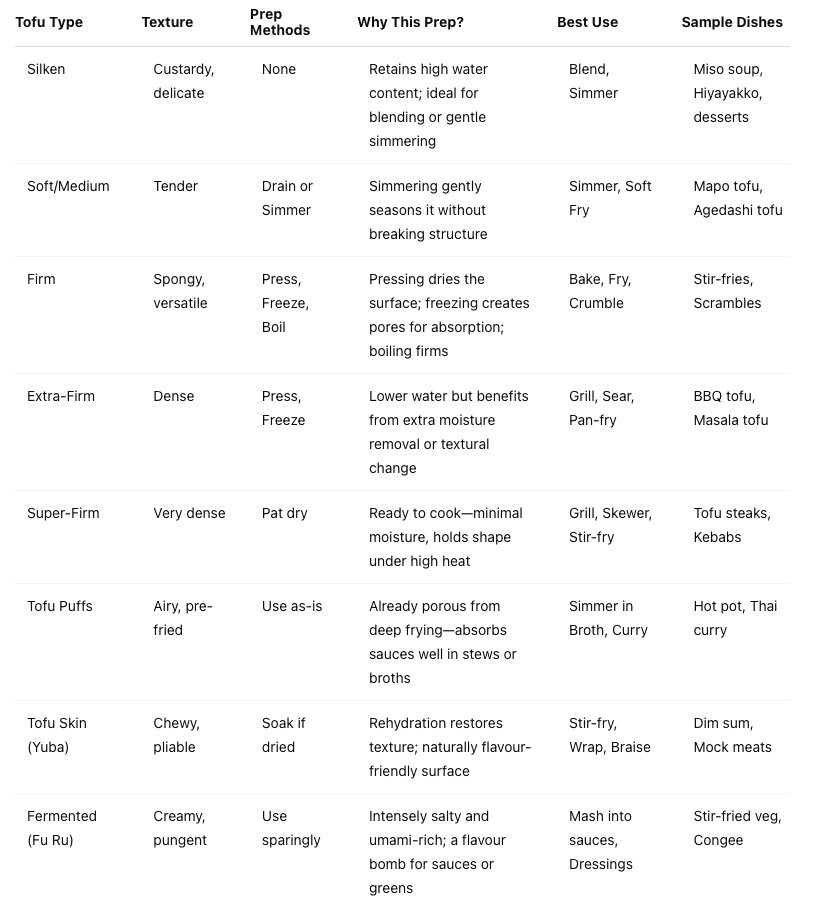How to Flavour Tofu: Asian, Western, and Global Cuisine Tips
Tofu’s bad rap as “bland” comes not from what it is, but from how it’s treated. This guide will teach you how to unlock deep, craveable flavour in tofu by working with its structure, not against it.
Not a blank sponge. A canvas — and a collaborator.
🥢 Why Tofu Doesn’t Just “Soak Up Flavour”
The truth? Plain tofu won’t absorb much unless you change its internal structure. Most tofu is about 80–85% water, held in a tight protein gel. Without intervention, marinades mostly stick to the surface (adsorption), not soak in (absorption).
So the question isn’t what sauce to use. It’s how to prepare tofu so it can hold and express that sauce.
Here’s how to do it.
🧊 Know Your Base – Types of Tofu and Why Prep Matters
🔬 Flavour Starts with Structure – The Science of Prep
Before tofu can carry flavour, it needs a structural reset:
Pressing (15–30 min): Removes surface water. Without this, tofu steams, not browns. Browning only happens when surface temps exceed 100°C (212°F)—dry tofu lets you reach Maillard reaction temperatures (140–165°C) for crisp, umami flavour.
Freeze-Thawing: Water turns to ice, rupturing the protein network. When thawed, tofu becomes porous, perfect for true absorption. Always press again post-thaw to remove released water.
Boiling in Salted Water: Hot water denatures proteins and expels internal moisture; salt draws water to the surface. This firms tofu and seasons it lightly from within. Great for faster prep.
Dry Pre-Cooking (Air fry/Pan fry): Quickly dehydrates surface, making it ideal for later saucing or glazing without sogginess.
These methods change how tofu behaves, allowing flavour to cling or infuse based on your cooking plan.
💧 How Tofu Actually Absorbs Flavour
Cold Marinades: For most tofu, this equals surface flavour only (adsorption). Unless tofu is freeze-thawed or pre-fried (puffed), its water-logged structure resists absorption. Oil-heavy marinades can further block water-based flavours.
Hot Glazes & Sauces: Apply right after high-heat cooking. Crisped surfaces + heat = perfect adhesion. No micro-pores—just thermal surface texture.
Simmering: Only gentle heat and long exposure allow true absorption. Use soft tofu in broths (e.g. Yudofu, Mapo Tofu) for best results.
🔥 Cooking Methods That Add Real Flavour
Pan-Frying/Searing: Develops a golden crust. Pressed or boiled tofu is needed.
Baking/Roasting: Tear tofu for crispier edges. Glaze midway.
Grilling: Use extra-firm, freeze-thawed, or super-firm. Brush with sauces containing sugar or starch for char and caramelisation.
Stir-Frying: Cook tofu separately first to brown it. Then toss with veg and sauce.
Simmering: Best for soft tofu. Infuses it deeply in spiced broths or sauces.
🌽 Crisp Factor – The Power of Starch & Alcohol
Starch Coatings: Cornstarch, potato starch, or arrowroot absorb water and crisp up in oil. Hydrate the starch briefly before frying for even coverage.
Why It Works: Upon heating, starch gelatinises, then rapidly dehydrates, forming a crunchy shell.
Advanced Tip – Vodka Trick: Replace some batter liquid with vodka. Alcohol evaporates fast, creating bigger bubbles = crisper crust. It also weakens gluten development in flour = lighter texture.
🌏 Tofu Around the World – A Global Canvas
🧠 Flavour Layering: Your 5-Step Strategy
Prep the Structure – Press, freeze, boil. Build the base.
Add Dry Rub or Starch – Coat in spices or cornstarch to deepen flavour or add crispness.
Cook to Brown – Pan-fry, roast, or grill to bring out Maillard magic.
Glaze or Sauce While Hot – Hot surfaces = better adhesion (adsorption).
Finish Fresh – Bright top notes: lemon juice, herbs, chilli oil, fresh zest.
Think like a perfumer: base → middle → top. Flavour = built in layers.
🎯 Final Thought
Tofu isn’t a passive vessel. It’s an active ingredient that transforms with heat, prep, and purpose.
Start with the structure. Build the layers. Respect the science. And cook with joy.
Go press, freeze, boil, glaze, and flavour like a pro. 🌱



